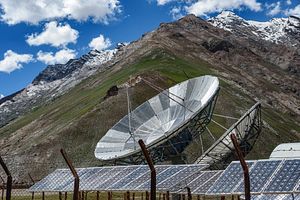Which country in the world is most concerned about climate change? The answer is not the United States or Britain, but Brazil. According to a recent Pew Global Attitudes Survey, more than 85 percent of Brazilians surveyed spoke of climate change as a “very serious problem.” By contrast, only 45 percent of those surveyed in America felt the same alarm.
This is not a one-off statistic. The overwhelming trend in the survey was higher concern shown by respondents in the developing world, compared to their more developed counterparts – more than 70 percent of people surveyed in India, Chile, Peru, Uganda and the Philippines voiced serious concern over climate change, while fewer than 50 percent did so in the United States, Britain, Poland and Australia.
Despite the increasingly proactive leadership of the West on climate change, this should come as no surprise. Most people in the developing world still earn their living from activities like farming and fishing that are vulnerable to the vagaries of climate. In India alone, millions of hectares of cropland suffered losses at different times this year, owing to unseasonal rain, the late arrival of monsoon and drought. The resultant hardship triggered hundreds of farmer suicides. Even fishermen along India’s southern coastline are having it increasingly tough, as unpredictable climate patterns disrupt fishing seasons.
For India, climate change is indisputably serious – perhaps more than it is for those in the developed world. Emissions, particularly in urban centers, have made air increasingly foul (the World Health Organization’s air pollution database in 2014 ranked Delhi as the worst among 1600 major cities in the world). But increased emissions seem inevitable. Prime Minister Narendra Modi launched his ambitious “Make in India” plan last year to kick start India’s industrialization, and the plan is certain to increase India’s carbon emissions over the next few decades. Plans to electrify vast areas of the country – where around 300 million people still have no access to electricity – will add to the burden.
All of this is unavoidable. Indeed, it would be unjust to deny India the opportunity to grow and lift millions out of poverty. But India needs cleaner, greener and more efficient solutions for its growth. This isn’t just about the environment; it is also about the economy – coal imports may cross 250 million tonnes this year and make up a substantial chunk of India’s current account deficit. While domestic coal output has increased, imports are unlikely to stall in the future, owing to the relatively lower quality of Indian coal and burgeoning demand. Better technology for growth, therefore, won’t just save the environment; it’ll also save India precious cash and make its manufacturing sector more competitive on the global stage.
The Modi government can’t be faulted for failing to prioritize on clean energy. In California earlier this year, the prime minister reiterated India’s commitment to produce 175 gigawatts of clean energy by 2022. But it won’t be easy. With the technology still nascent, renewable energy is inevitably costlier than traditional fossil fuel (falling crude prices have only made the gap wider). A World Bank study estimates that it will cost India between $10 billion and $64 billion in subsidies over the next decade to meet its renewable energy goals. Experts at Modi’s California summit also raised the concern that India’s current grid is not capable of carrying the 175 GW of energy which Modi has targeted. And many of India’s state-owned power distribution companies are already mired in debt.
India’s yearning for clean energy is shared by most countries in the developing world, but so is India’s resource crunch. If the developing world is to successfully switch to clean energy, it will need money as well as the research capacity and equipment required to develop homegrown technological solutions for clean energy. Countries like India have a large crop of young scientists and engineers capable of undertaking cutting-edge research on clean energy, but lack the institutions for it. Much like any other form of scientific research, clean energy solutions too are largely limited to the West.
The summit at Paris later this month provides India a massive opportunity to lead the way in rectifying this global divide by giving voice to the developing world’s aspirations and concerns. India ought to lobby fervently for a global institutional framework for technology transfer and joint international research in the field of clean energy in order to coordinate global efforts towards the cause. Paris ought to yield more than promises to cut emissions. It also ought to present an institutionalized framework to get there.
Mohamed Zeeshan is a policy analyst based in Bangalore, India and a columnist for Swarajya and The Huffington Post. A version of this article was previously published in Swarajya.
































